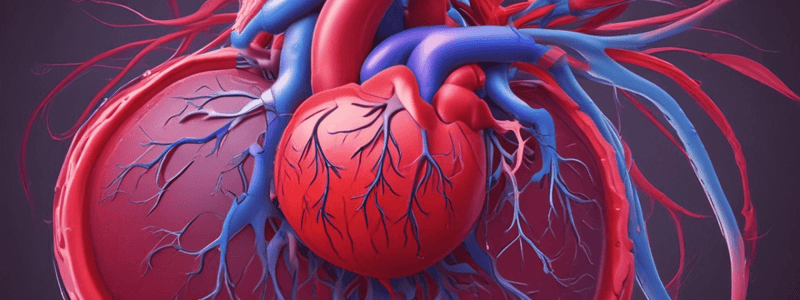Podcast
Questions and Answers
What is the primary function of the systemic system in the circulatory system?
What is the primary function of the systemic system in the circulatory system?
- To transport oxygen-depleted blood from tissues to the heart
- To prevent backflow of blood in the arteries
- To aid in the diffusion of oxygen and nutrients in capillaries
- To transport oxygen-rich blood from the heart to tissues and organs (correct)
Which type of blood vessel carries oxygen-rich blood away from the heart?
Which type of blood vessel carries oxygen-rich blood away from the heart?
- Veins
- Venules
- Capillaries
- Arteries (correct)
What occurs during diastole in each heartbeat?
What occurs during diastole in each heartbeat?
- The venules absorb oxygen-depleted blood
- The ventricles contract and forcefully expel blood
- The ventricles relax and allow blood flow into them (correct)
- The atrio-ventricular valves prevent backflow of blood
Which is a significant contributor to morbidity and mortality globally related to the circulatory system?
Which is a significant contributor to morbidity and mortality globally related to the circulatory system?
What is the purpose of venules in the circulatory system?
What is the purpose of venules in the circulatory system?
What is the role of arteries in the circulatory system?
What is the role of arteries in the circulatory system?
What is the primary function of the circulatory system?
What is the primary function of the circulatory system?
Which of the following chambers of the heart pumps oxygen-rich blood to the body?
Which of the following chambers of the heart pumps oxygen-rich blood to the body?
What is the function of the sinus node in the heart?
What is the function of the sinus node in the heart?
Which of the following systems is responsible for exchanging oxygen and carbon dioxide through the lungs?
Which of the following systems is responsible for exchanging oxygen and carbon dioxide through the lungs?
What is the function of the valves in the heart?
What is the function of the valves in the heart?
Which of the following is NOT a component of the circulatory system?
Which of the following is NOT a component of the circulatory system?
Flashcards are hidden until you start studying
Study Notes
The Circulatory System: An Essential Network for Delivery and Waste Removal
Introduction
The circulatory system, also known as the cardiovascular system, is a complex network of organs and blood vessels that serves multiple crucial functions within the human body. This extensive framework acts as a delivery system for essential nutrients, oxygen, and hormones while simultaneously serving as a waste removal system for waste products such as carbon dioxide. In this article, we will explore the intricate mechanisms underlying the circulatory system, discussing its structure, function, and the diseases that may arise due to dysfunction.
Structure and Function
Components of the Circulatory System
The Heart
At the core of the circulatory system lies the heart, a muscular organ responsible for pumping blood throughout the body. The heart features four chambers: the left and right atria, and the left and right ventricles, all separated by one-way valves to ensure unidirectional blood flow. The sinus node, located at the top of the right atrium, initiates the heart's electrical impulses, controlling the rate and rhythm of contractions.
Blood Vessels
Two distinct networks constitute the circulatory system: the pulmonary and systemic systems. The pulmonary system is responsible for exchanging oxygen and carbon dioxide through the lungs, ensuring that oxygen-depleted blood from the body is returned to the heart. The systemic system, on the other hand, transports oxygen-rich blood from the heart to various tissues and organs throughout the body, as well as collecting oxygen-depleted blood for return to the heart.
Arteries, Capillaries, and Veins
The circulatory system utilizes three primary types of blood vessels: arteries, capillaries, and veins. Arteries are thick-walled vessels that carry oxygen-rich blood away from the heart, transitioning into progressively smaller arterioles and finally forming dense networks of capillaries, where diffusion of oxygen and nutrients occurs. Venules absorb the oxygen-depleted blood returning from the tissues and merge into small, medium, and large veins, eventually returning to the right atrium of the heart.
Heartbeats and Circulation Phases
Each heartbeat comprises two distinct phases: systole and diastole. During systole, the ventricles contract and forcefully expel blood into the pulmonary artery or the aorta, while the atrio-ventricular valves prevent backflow. Conversely, during diastole, the ventricles relax, allowing the atrio-ventricular valves to open, allowing blood flow into the ventricles from the atria. These phases ensure efficient circulation within the circulatory system.
Diseases of the Circulatory System
Heart disease is a significant contributor to morbidity and mortality globally, with conditions such as stroke, heart attack, hypertension, and various forms of cardiovascular disease being prime examples of diseases affecting the circulatory system. Understanding the mechanisms underlying these disorders can aid in the development of targeted interventions aimed at maintaining cardiovascular health and preventing complications.
Conclusion
In summary, the circulatory system plays an essential role in sustaining life through its delivery and waste removal functions. By understanding the structure and function of its components, as well as the implications of circulatory system diseases, we gain valuable insights into maintaining optimal cardiovascular health and preventing associated pathologies.
Studying That Suits You
Use AI to generate personalized quizzes and flashcards to suit your learning preferences.



